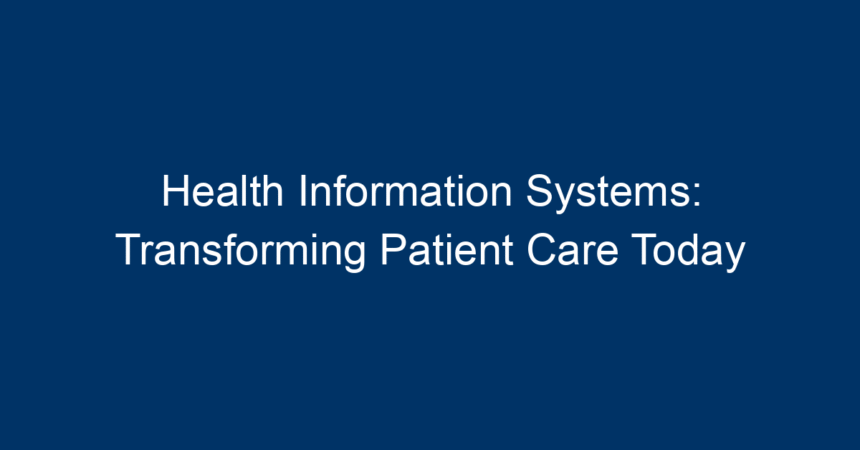In the rapidly evolving landscape of healthcare, health information systems (HIS) play a pivotal role in revolutionizing patient care. These comprehensive frameworks are crucial not only for managing patient data but also for enhancing the overall efficiency of healthcare delivery. As hospitals and clinics confront the dual challenges of an aging population and increasing demands for quality care, the role of HIS has never been more significant. This article delves into the transformative impact of health information systems on patient care, examining their functionalities, benefits, challenges, and future trends.
Understanding Health Information Systems
What is a Health Information System?
A Health Information System (HIS) is an integrated system designed to collect, store, manage, and disseminate health data for health organizations. It encompasses various components, including electronic health records (EHRs), telemedicine, and data analytics platforms. By providing timely and accurate information, HIS enhances decision-making, improves patient safety, and facilitates communication among healthcare providers.
Key Components of Health Information Systems
-
Electronic Health Records (EHRs): EHRs are digital versions of patients’ paper charts. They include medical history, treatment plans, allergies, test results, and other relevant data. EHRs enhance the accessibility and continuity of care.
-
Clinical Decision Support Systems (CDSS): These systems provide healthcare professionals with knowledge and patient-specific information, intelligently filtered or presented at appropriate times, to enhance patient care.
-
Telemedicine Platforms: Telemedicine facilitates remote patient monitoring, virtual consultations, and health education, providing patients with more accessible healthcare options.
- Health Information Exchange (HIE): HIE allows for the sharing of patient information across different healthcare settings. This seamless transfer of data is crucial for coordination and improved outcomes.
The Impact of Health Information Systems on Patient Care
Enhanced Data Management
One of the primary benefits of health information systems is enhanced data management. With HIS, healthcare providers can efficiently gather and analyze patient data, leading to informed clinical decision-making. Aggregate data analysis helps identify health trends and improve treatment protocols, ultimately enhancing patient outcomes.
Improved Patient Safety
Health information systems significantly reduce the risk of medical errors. For example, computerized physician order entry (CPOE) systems allow for the electronic submission of medication orders. This system reduces misunderstandings related to handwriting and suboptimal communication, leading to safer medication administration. Alerts regarding potential drug interactions can also be integrated into EHRs, promoting patient safety.
Optimized Communication and Collaboration
HIS fosters improved communication among healthcare teams. When providers have real-time access to patient data and histories, the care coordination process becomes more streamlined. This level of transparency can lead to better interdisciplinary collaboration, ensuring that patients receive comprehensive and cohesive care.
Increased Patient Engagement
Health information systems empower patients by granting them access to their health data. Patient portals—secure online platforms where users can view their medical records, schedule appointments, and communicate with healthcare providers—encourage active participation in one’s healthcare journey. Higher patient engagement has been linked to increased satisfaction and improved outcomes.
Cost-Effectiveness
While the investment in health information systems may initially seem significant, they often lead to long-term cost savings. HIS reduces administrative costs and enhances operational efficiencies. By minimizing redundant testing and hospital readmissions through improved data accuracy and coordination, organizations can save substantial amounts of money over time.
Challenges in Implementing Health Information Systems
Despite their numerous benefits, implementing health information systems is not without challenges. Here are some common hurdles that healthcare organizations face:
High Implementation Costs
The financial burden of purchasing and maintaining HIS can be daunting. In addition to software and hardware costs, healthcare organizations must invest in training staff and maintaining the system.
Data Security Concerns
As healthcare data increasingly moves online, organizations must ensure that patient information is secure. Cybersecurity threats are a growing concern, necessitating robust security measures to protect sensitive data from breaches.
Resistance to Change
Healthcare providers may resist transitioning from traditional paper-based systems to electronic formats. Training staff and encouraging a culture of adaptability is essential for successful implementation.
Interoperability Issues
Achieving seamless communication between different health information systems can be challenging. Variations in standards and protocols can hinder the effective sharing of patient data across platforms.
Future Trends in Health Information Systems
The future of health information systems holds exciting possibilities that promise to further enhance patient care:
Artificial Intelligence and Machine Learning
AI and machine learning are set to revolutionize health information systems by enabling predictive analytics, automating routine tasks, and facilitating personalized care. For instance, algorithms can analyze patient data to identify those at risk of conditions like diabetes or heart disease, enabling early interventions.
Blockchain Technology
Blockchain technology offers a decentralized and secure method to manage patient data. This could significantly enhance data integrity and security while allowing patients greater control over their own information.
Remote Patient Monitoring
As telemedicine continues to expand, remote patient monitoring (RPM) will play a central role in chronic disease management. HIS will integrate with devices that monitor areas like blood pressure and glucose levels, allowing providers to track patient progress in real-time.
Actionable Insights for Healthcare Organizations
-
Invest in Training: While implementing health information systems can be challenging, ensuring that staff are adequately trained will lead to better adoption and utilization.
-
Prioritize Data Security: Implement robust cybersecurity measures to safeguard patient information against breaches and cyber threats.
-
Encourage Patient Engagement: Utilize patient portals and other digital tools to enhance patient engagement, leading to better outcomes and higher satisfaction.
-
Stay Updated on Trends: Keep abreast of emerging technologies in health information systems, such as AI and blockchain, to remain competitive and deliver cutting-edge care.
- Foster Interoperability: Choose HIS solutions that promote interoperability with other systems to ensure seamless information flow and better coordinated care.
Conclusion
The evolution of health information systems is transforming patient care, enhancing the efficiency and quality of healthcare delivery. By leveraging various components—ranging from EHRs to telemedicine—healthcare organizations can significantly improve data management, patient safety, communication, and overall patient outcomes. While challenges remain, the future of HIS holds great promise. By adopting forward-thinking strategies, healthcare providers can harness the full potential of health information systems, ultimately providing better care for patients today and in the future.




